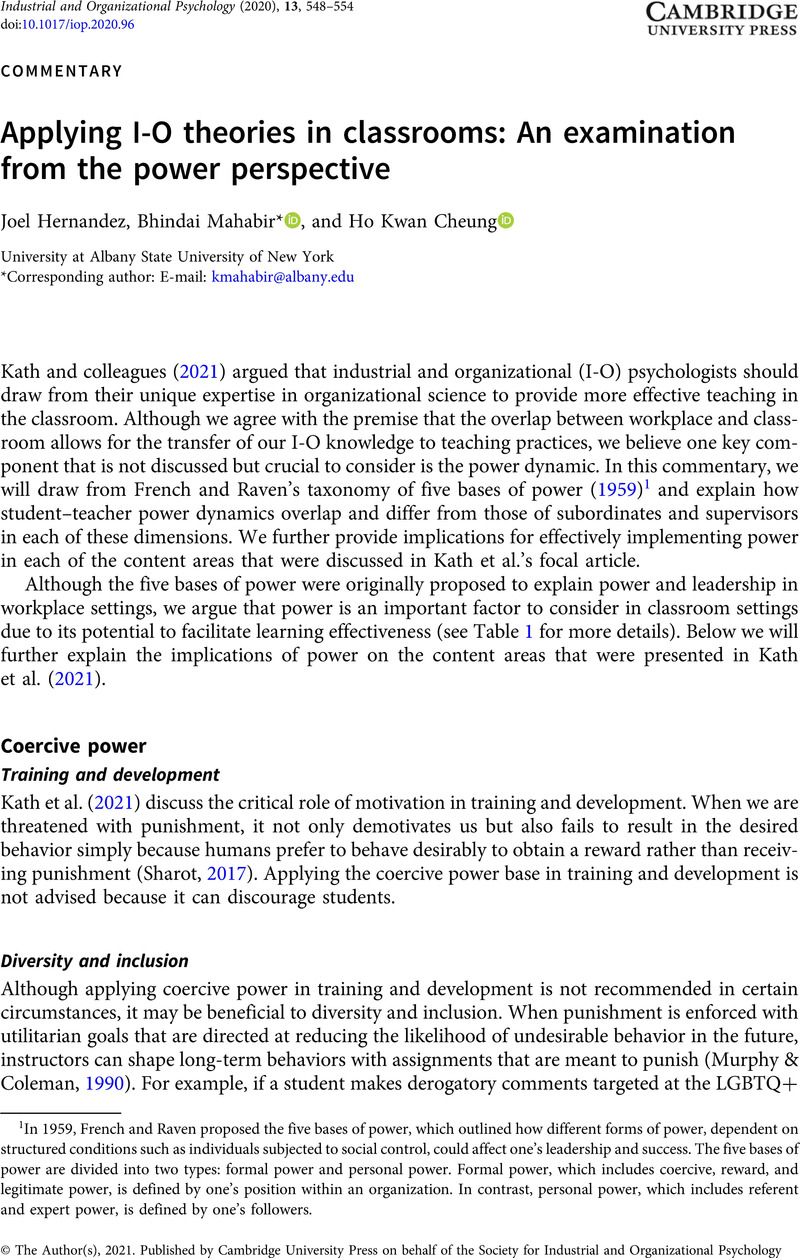No CrossRef data available.
Article contents
Applying I-O theories in classrooms: An examination from the power perspective
Published online by Cambridge University Press: 08 February 2021
Abstract
An abstract is not available for this content so a preview has been provided. Please use the Get access link above for information on how to access this content.

- Type
- Commentaries
- Information
- Copyright
- © The Author(s), 2021. Published by Cambridge University Press on behalf of the Society for Industrial and Organizational Psychology
References
Barbuto, J. E. Jr. (2005). Motivation and transactional, charismatic, and transformational leadership: A test of antecedents. Journal of Leadership & Organizational Studies, 11(4), 26–40.CrossRefGoogle Scholar
Bass, B. M., Avolio, B. J., Jung, D. I., & Berson, Y. (2003). Predicting unit performance by assessing transformational and transactional leadership. Journal of Applied Psychology, 88(2), 207–218.CrossRefGoogle ScholarPubMed
Ben-Elia, E., & Ettema, D. (2011). Rewarding rush-hour avoidance: A study of commuters’ travel behavior. Transportation Research Part A: Policy and Practice, 45(7), 567–582.Google Scholar
Carless, S. A., Wearing, A. J., & Mann, L. (2000). A short measure of transformational leadership. Journal of Business and Psychology, 14(3), 389–405.CrossRefGoogle Scholar
Dunn, E. J., Mills, P. D., Neily, J., Crittenden, M. D., Carmack, A. L., & Bagian, J. P. (2007). Medical team training: Applying crew resource management in the Veterans Health Administration. Joint Commission Journal on Quality and Patient Safety, 33(6), 317–325.CrossRefGoogle ScholarPubMed
Ericsson, K. A. (2004). Deliberate practice and the acquisition and maintenance of expert performance in medicine and related domains. Academic Medicine, 79(10), S70–S81.CrossRefGoogle Scholar
French, J. R. Jr. P., & Raven, B. H. (1959). The bases of social power. In Cartwright, D. (Ed.), Studies in social power (pp. 150–167). Institute for Social Research.Google Scholar
Garbers, Y., & Konradt, U. (2014). The effect of financial incentives on performance: A quantitative review of individual and team-based financial incentives. Journal of Occupational and Organizational Psychology, 87(1), 102–137.CrossRefGoogle Scholar
Gauld, D., & Miller, P. (2004). The qualifications and competencies held by effective workplace trainers. Journal of European Industrial Training, 28(1), 8–22.CrossRefGoogle Scholar
Grandey, A. A., Chi, N. W., & Diamond, J. A. (2013). Show me the money! Do financial rewards for performance enhance or undermine the satisfaction from emotional labor? Personnel Psychology, 66(3), 569–612.CrossRefGoogle Scholar
Haskell, R. E. (1997). Academic freedom, tenure, and student evaluation of faculty: Galloping polls in the 21st century. Education Policy Analysis Archives, 5(6).CrossRefGoogle Scholar
Hassi, A., Storti, G., & Azennoud, A. (2011). Corporate trainers’ credibility and cultural values: Evidence from Canada and Morocco. Cross Cultural Management: An International Journal, 18(4), 499–519.CrossRefGoogle Scholar
Jacobs, R. L. (1987). Human performance technology: A systems-based field for the training and development profession. National Center for Research in Vocational Education, Ohio State University.Google Scholar
Johnson, D. W., & Johnson, R. T. (2005). Cooperative learning, values, and culturally plural classrooms. In Mal Leicester, Sohan Modgil, & Sohan Modgil (Eds.), Classroom Issues (pp. 29–47). Routledge.Google Scholar
Johnson, M. D., Hollenbeck, J. R., Humphrey, S. E., Ilgen, D. R., Jundt, D., & Meyer, C. J. (2006). Cutthroat cooperation: Asymmetrical adaptation to changes in team reward structures. Academy of Management Journal, 49(1), 103–119.CrossRefGoogle Scholar
Kath, L., Salter, N., Bachiochi, P., Brown, K., & Hebl, M. (2021). Teaching I-O psychology to undergraduate students: Do we practice what we preach? Industrial and Organizational Psychology: Perspectives on Science and Practice, 13(4), 443–460.Google Scholar
Kouzes, J. M., & Posner, B. Z. (1990). The credibility factor: What followers expect from their leaders. Management Review, 79(1), 29–33.Google Scholar
Leach, J. (1996). Training, migration, and regional income disparities. Journal of Public Economics, 61(3), 429–443.CrossRefGoogle ScholarPubMed
Lin, Y. G., McKeachie, W. J., & Kim, Y. C. (2003). College student intrinsic and/or extrinsic motivation and learning. Learning and Individual Differences, 13(3), 251–258.CrossRefGoogle Scholar
Machin, M. A. (2002). Planning, managing, and optimizing transfer of training. In Kraiger, K. (Ed.), Creating, implementing, and managing effective training and development (pp. 263-301). John Wiley & Sons.Google Scholar
Miendlarzewska, E. A., Bavelier, D., & Schwartz, S. (2016). Influence of reward motivation on human declarative memory. Neuroscience & Biobehavioral Reviews, 61, 156–176.CrossRefGoogle ScholarPubMed
Murphy, J. C., & Coleman, J. L. (1990). Philosophy of law: An introduction to jurisprudence. Westview Press.Google Scholar
Pearsall, M. J., Christian, M. S., & Ellis, A. P. (2010). Motivating interdependent teams: Individual rewards, shared rewards, or something in between? Journal of Applied Psychology, 95(1), 183–191.CrossRefGoogle ScholarPubMed
Podsakoff, P. M., Bommer, W. H., Podsakoff, N. P., & MacKenzie, S. B. (2006). Relationships between leader reward and punishment behavior and subordinate attitudes, perceptions, and behaviors: A meta-analytic review of existing and new research. Organizational Behavior and Human Decision Processes, 99(2), 113–142.CrossRefGoogle Scholar
Pollard, D. S. (1989). Reducing the impact of racism on students. Educational Leadership, 47(2), 73–75.Google Scholar
Pounder, J. S. (2006). Transformational classroom leadership: The fourth wave of teacher leadership? Educational Management Administration & Leadership, 34(4), 533–545.CrossRefGoogle Scholar
Sabat, I. E., Martinez, L. R., & Wessel, J. L. (2013). Neo-activism: Engaging allies in modern workplace discrimination reduction. Industrial and Organizational Psychology, 6(4), 480–485.CrossRefGoogle Scholar
Sharot, T. (2017). What motivates employees more: Rewards or punishment. Harvard Business Review. https://hbr.org/2017/09/what-motivates-employees-more-rewards-or-punishments
Google Scholar
Thompson, K. D. (2001). Adult educator effectiveness within the training context: A study of trainee perceptions of effective trainer characteristics. [Unpublished Doctoral dissertation]. University of Wyoming, Laramie.Google Scholar
Tucker, B. A., & Russell, R. F. (2004). The influence of the transformational leader. Journal of Leadership & Organizational Studies, 10(4), 103–111.CrossRefGoogle Scholar
Yahaya, N., Taib, M. A. B. M., Ismail, J., Shariff, Z., Yahaya, A., Boon, Y., & Hashim, S. (2011). Relationship between leadership personality types and source of power and leadership styles among managers. African Journal of Business Management, 5(22), 9635–9648.Google Scholar


